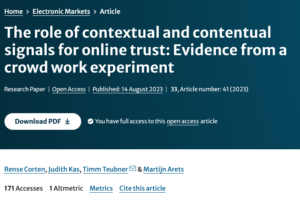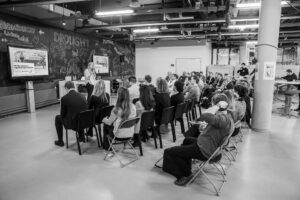‘It’s allowed to make mistakes’ is a lofty phrase used by many managers and business leaders, but in practice there are only a few stories to read about the lessons learned from failures. What a waste it is; therefore, I’m willing to discuss and share mine with the associated lessons I’ve learned.
I’ll be talking about crowdfunding. In 2011, I have been the first person in the world to finish a share-based crowdfunding campaign. 171 investors accumulated 20.000 euro for translating, designing, and printing of the English version of my book, Brand Expedition: A Journey Visiting Europe’s Most Inspiring Brands, within 10 weeks. A book as a business with the ambition to be marketed as an international bestseller. Now, more than 5 years on, the project of the English book has been discontinued officially. The enormous ambitions and the boundless energy haven’t resulted in the desired results, and both the investors and I are left empty handed. In this article, I’ll look back on the crowdfunding adventure and share my ‘lessons learned’.
Crowdfunding lesson 1: Why people invest?
This book campaign was marked by the choice for crowdfunding with shares through the Symbid platform. First of all, this hasn’t been a strategic choice, but one that came by happenstance. I know someone involved in Symbid and he convinced me of the idea to crowdfund. To me, an interesting chance to realize my ambitions for an international bestseller and a great success case for Symbid. The book and the story of my journey were quite well-known (150+ publications in all imaginable media).
In hindsight, one may ask if the choice for crowdfunding with shares had been the best option. The question I should have asked myself is: Why would people invest in my dream, and help me realize an English version of my book, which was successful in The Netherlands?
Of course, I posed the question to quite a few investors. What turned out is that the broad majority took part because they fancied the idea or they were in for their own benefit in a signed copy of the book, an consulting session, or a presentation. The expectation of ‘an overwhelming profit’ wasn’t mentioned by anyone. Not so surprising in itself as the value of the book will only decrease over time; and, with an average investment of about 50 euro, it wouldn’t have made anyone rich.
If most investors weren’t in it for the profit, the choice of crowdfunding with shares, being wise after the event, hasn’t been the right choice. Maybe I would have accumulated a couple thousand euro less, but for the choice of a shares campaign I had to pull up Book BV, a private limited liability company, and Book Cooperative UA, an official cooperative, and my sole proprietorship had to be turned into a private limited liability company forcefully. This just because the 80% of the remaining shares for me, with a paper value of 80,000 euro, were perceived as profit by the tax authority. I was almost forced to pay tax over this amount. Without this construction, only half of the money would have been sufficient.
Crowdfunding lesson 2: The valuation?
Coming up with a decent valuation of a non-existing company is a troublesome task. In my case, I sold 20% of the shares in Book BV for 20,000 euro, which implied a valuation of my book of 100,000 euro. Despite the great ambitions we had for the book, one may say that the valuation was still quite sassy for a book of an obscure author, regardless of his reputation within the Netherlands. And by the way, he had decided to publish the book independently and solely sell it on the internet.
CONTEXT : At the valuation of the book, we presumed an ambitious, and in retrospect vulnerable, scenario in which the book would become an international bestseller. Nowadays, there are crowdfunding variants on the market in which the valuation is postponed, a so-called ‘convertible loan’. One raises funds from the crowd in exchange for a loan with an x interest rate. At the time the next bigger investor joins, the previous investor will be offered the opportunity to convert the the loan into a share. The initiative has usually lasted for some more months or years by which the valuation can be based on far more information. Moreover, the mostly young and inexperienced crowd benefits from the knowledge and negotiation power of this investor.
Crowdfunding lesson 3: Choose the right funding target.
I had chosen a funding target of 20,000 euro for my campaign. This amount was reserved for the translation (5,000), the design (2,000), the print of the book (10,000), and the establishment of both the private limited liability company and the cooperative (5,000). Besides, 20,000 euro was also the minimum amount to crowdfund at Symbid, partially based on the fact that 18,000 euro was needed to establish a private limited liability company.
20,000 euro was actually to little, as the sum of the costs mentioned above already accounts for 22,000 euro. In addition, I needed an office, ICT infrastructure, diverse subscriptions, and I had to put bread on the table for myself. I, furthermore, employed a complete team of interns and volunteers, incurring considerable costs.
In order to give the project a chance, I invested over a year of my time (excluding the time for preparations and the campaign) and bore many of the cost personally.
I could have chosen a cheaper solution or should have raised more money. The assumption that additional cost would sufficiently be covered by book sales coming into swing, was, looking back, a risk I should have arranged for with a bigger margin.
Crowdfunding lesson 4: Does your crowd match the audience of your project?
Although the audience of my English book would not be in the same country, the overwhelming majority of my investors lived in the Netherlands. Of course it was logical to raise money among the Dutch as my network and reputation were mainly directed to the Netherlands, but it made it much harder to set the stage outside of my home country.
Realistically I think that It wouldn’t have been possible to crowdfund the project fully outside of the Netherlands, for my reputation and network weren’t sufficiently established there. Next time, I will be looking for a better mix between the two.
Crowdfunding lesson 5: Community management is an art in itself.
Crowdfunding sounds fancy: you’re obtaining, besides the ‘funding’, also an involved ‘crowd’ with your campaign. In my case 171 investors. But at the time you’re busy establishing your company or project, it will be hard to keep that audience involved. I have invested in several hundreds of crowdfunding projects to see how others deal with this. Conclusion: the number of project owners communicating well with their supporters can be counted on the fingers of one hand.
Reflecting on my whereabouts, I’ve send an update to my investors about the progress with a certain regularity. I also made an analysis of the several areas in which the investors are actively involved and which of these could be beneficial in finding answers on certain questions. But as the ambition to market a translation slowly showed less and less feasible, my contact with my investors worsened rapidly.
This is my main lesson: Plan ahead for ways to involve the crowd and devote time to it. Also when you’ve got the feeling things won’t work out as planned. Perhaps, even more so in such cases.
In the end, Book BV and the Book Cooperative UA have existed for five years, although it was clear that the project would not meet the ambitions we used to have. The reason? I didn’t want to admit things had failed to work out. I also dreaded the administrative hassle[4] associated with the termination of the private limited liability company and the cooperative, which wasn’t necessary at all. Quit as soon as you know that things won’t take a turn for the better anymore.
Business lesson 1: Don’t immediately write off the status quo.
Crowdfunding is often seen as: ‘Power to the crowd and fuck the status quo’. Initially, this was my perspective too. By releasing my English book, I would neglect banks, publishers and book stores on my way to international success.
Although an individual with a common sense may achieve a lot these days, one has to question himself if his choice is the best. Something being possible, doesn’t automatically imply that you should do so[5] . Regarding the publishing of my book, I organized everything concerning the translation, design, print, distribution, and marketing myself. If I would have asked myself where my strengths are and what it is that gives me energy, it wouldn’t have been the negotiations with printers and distributors. Exactly that part took most of my time.
For my (upcoming) books Crowdfunding, de hype voorbij, Crowdfunding voor Dummies, Wavemakers and Platformrevolutie I did ask myself that question. Hence, I became aware of what I expected from a publisher (editing, production, access to sales channels and access to an events network). This has benefitted the quality of the productions.
Keeping everything in your own hands has the advantage of teaching you how everything works and what is and isn’t possible.
Business lesson 2: Don’t let success be dependent on only 1 idea.
My plan to make my English translation world-famous seemed infallible. For the promotion of the book I challenged over a hundred million Facebook fans of the 20 brands, described in my book, to make my book the first video-audiobook in the world. Every fan would read a fragment of the chapter about their brand on camera. Thousands of readers would realize this audiobook. That in itself should boost the sales of the book.
Practice turned out to be more intractable; it was hard to reach the fans. I didn’t succeed in convincing the brands of the added value of this campaign and the threshold of putting yourself on video to read a piece seemed too high. Through many detours I collected a few hundred videos. I hired people from several countries through Fiverr.com to contribute, made deals with discounts on presentations in exchange for movies of the coworkers and more. Unfortunately, it couldn’t bring the viral effect to the campaign like I had in mind.
Subsequently, I tried to catch the attention of bookstores in the UK with a targeted guerilla action, hired a scout to gauge the interest of publishers in Germany and the UK, tried to allure brands with great deals, and opened up a box of other ideas to ultimately get sales up, but I didn’t make headway.
Business lesson 3: Borders remain existent even in the internet era.
Although it seems that borders are inexistent because of the internet –I contact people from at least 5 countries on a regular day– such is not the case for the physical business world. My idea, to sell my book from the Netherlands to anyone in the world, turned out to be opportunistic. It proved that Germans prefer German books and the French population prefers to read French books. On top of that, it was hardly possible to get the attention of the media and other partners as an obscure newcomer to another country. You rather build your reputation and network in a country first, before eventually launching a book (especially when published by yourself).
Business lesson 4: Know when to quit.
The money of the crowdfunding campaign had been spent on the production costs in the first months. I had spent over a year on the project and still a stack of a few thousand prints filled my office space. Moreover, nothing indicated tides would possibly change.
The question, “Shouldn’t I quit?” ran through my mind several times, but accepting that the adventure had ended and the process of finishing the project, for which 2 limited liability companies and a Cooperative were established, with which I had to deal, caused me to remain indecisive year after year.
At some point, earlier this year, I decided on the termination. As I communicated this to the investors, reactions were generally very positive. Most often, the feedback I received sounded: “Why did you leave ends loose for so long? My most important lesson: Quit when you have to quit. Leaving things unfinished only cost unnecessary energy and money, and in the end you do know –being honest with yourself– which solution is best. So, also reminding myself, get yourself together and have the guts to quit something!
Business lesson 5: Success is found in the bigger picture.
The English book project has cost, besides the investor’s money, almost 100 grand of my own money as well. An estimated accumulation of the cost I’ve personally contributed to the project consistent of ‘lost’ hours, extra paid taxes, the additional notary and accountant costs, and the expenses of campaigns; all was I paid from my own pocket.
Economically you may say: “It has been a massive failure.” You feel the ‘but’ coming. Without this crowdfunding campaign I wouldn’t have had a chance to beat John de Mol in the Sprout challenge for ‘best entrepreneur of the year’. I wouldn’t have been invited to become one of the ‘40 Young Potential Leaders under 40’. I would have never written two books about crowdfunding. And, finally, my interest for the platform economy, of which crowdfunding is a part, would not have been aroused in me. This subject has had my attention for the last four years. Since November 1st, I’m working at the Universtiy of Utrecht, in the conviction that the platform economy will influence all imaginable industries in the years to come.
If I would look at the financial result of the English translation of the book only, while answering the question “Are you successful?”, I would say: “No. Absolutely not.” But when I look at the bigger picture, I’m sure that without this campaign I wouldn’t have achieved as much as I have achieved. In this regard I don not see myself as a victim of the mistakes I made; the mistakes I made ultimately contributed to a better version of myself. And I’m thankful for the fact that these chances have been created and been given to me.
In conclusion
Although some lessons sound no less than logical in today’s context, it is important to recognize that the crowdfunding landscape looked completely different in 2011. This puts a ‘which is logical’ in a whole other perspective.
When looking back to this educational adventure, in which I have not been able realize the huge ambitions of the English version of the book as a worldwide business success, but including the pocketed experience, I have achieved things of which I had not dared to dream or think.
I couldn’t have made this unforgettable trip without the support of the crowdfunders; thank you for your trust. Also a big ‘thank you’ to Schuiteman Accountants & Adviseurs, the office I’ve been working together with over the last few years. They make sure, in exchange for insights in the platform economy, that I don’t have to worry about putting up a Christmas tree, which has been taken down already. Additionally, I would like to thank Wim Kiezenberg of DesignAgain, Paul of Jool.nl, Kim of Hosting on Demand, and Alfred of Imagine People for their contributions. Finally, I’d like to thank all volunteers and interns who have worked together with me during this part of the expedition: Germaine, Dave, Tamara, Peter, Martin, Maarten, Bjorn, Stephanie, Jos, Jurgen and Kelly. Thank you all!
Header photo: Martijn Arets, expedition leader of Crowd Expedition, photo by Sebastiaan ter Burg, CC BY 2.0



